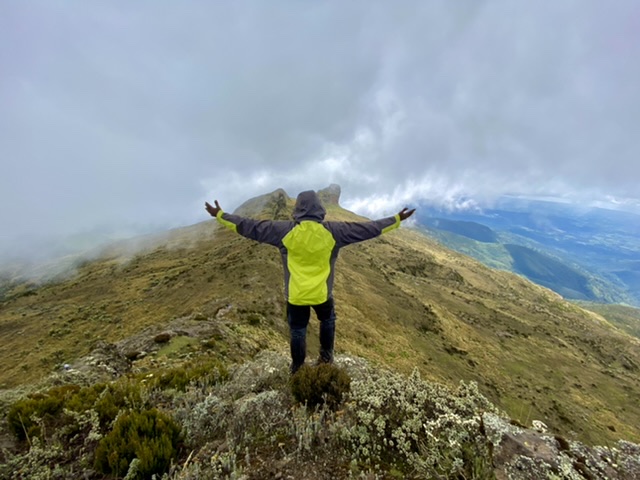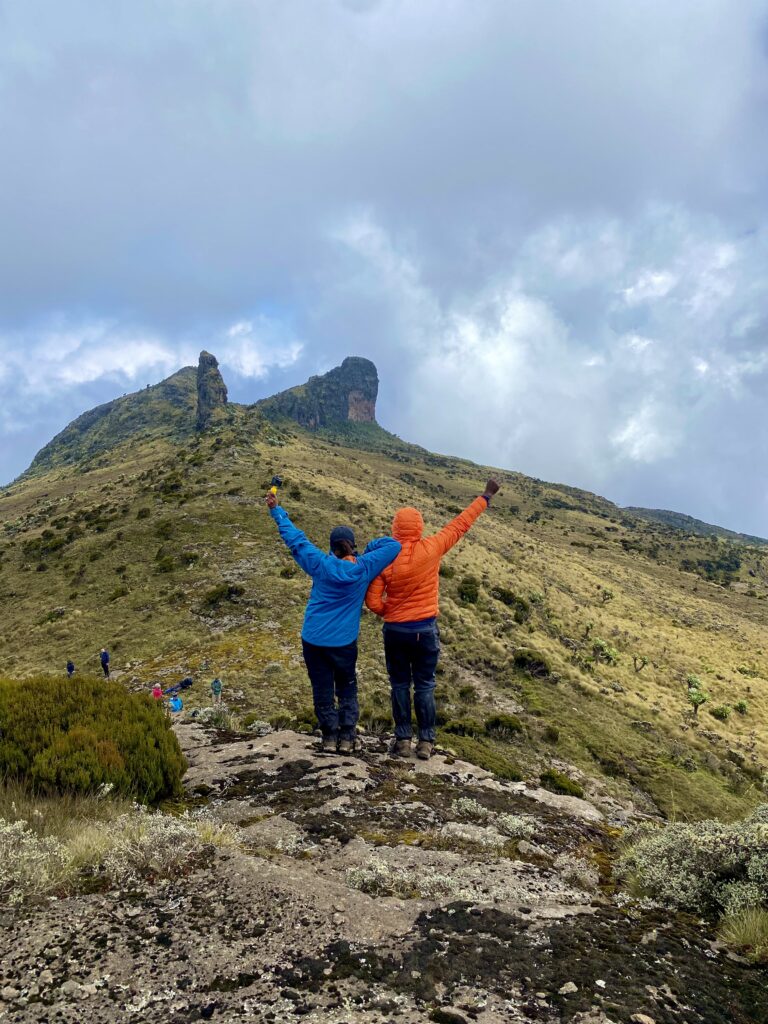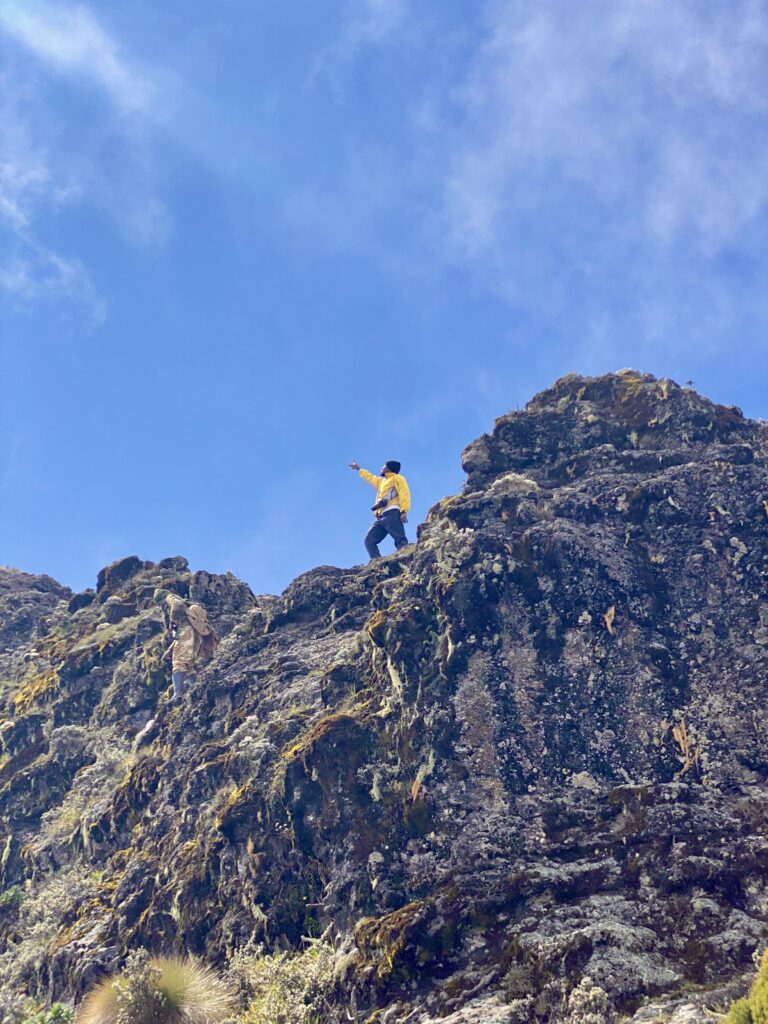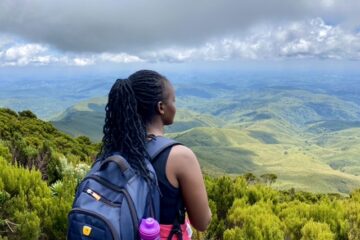All Hail The Mother!

While Mt Kinangop goes by the moniker “Mother Kinangop,” she is anything but motherly! Mt Kinangop hike is torturous, the summit is difficult to access, and scaling it is a definite death wish for the average hiker. Is it her way of expressing distaste for being the second-highest peak of the Aberdare Range? I guess we’ll never know!
Hikers can access Mt. Kinangop via two trails: the direct Mutarakwa Forest trail and the infamous Elephant hill route. The latter goes over the Elephant Hill summit first, in the name of killing two birds with one stone. Both trails are physically exerting and are a reserve for advanced hikers only. We shall focus our attention on the direct Mount Kinangop Mutarakwa Forest trail.

Journey Through Mt Kinangop Hike
Rising to an elevation of 3,906m (12,815 ft.), Mount Kinangop is a 3 hours’ drive from Nairobi via Kiambu and Nyandarua Counties to Mutarakwa Forest Station, where the hike kicks off. Pine and cypress trees, planted through Shamba System reforestation projects, feature prominently on the first part of the trail. The Shamba System is an agreement between the locals and the government authorities, which allows them to till deforested land for subsistence farming and in turn plant trees. Once the trees grow to a certain height, the farmers stop tilling the land and leave the planted forests to thrive.
The Shamba System soon gives way to dense vegetation with tall indigenous trees blocking sun rays, while tons of stinging nettles remind you that your 10-hour Mt Kinangop hike is bound to be dramatic.
The Notorious Bamboo Section
Within an hour, the trail shifts from lush forest to bamboo canopies. These canopies render the trail poorly lit, wet, and slippery year-round. Their crackling sounds echo throughout the forest every so often, you might mistake them for the presence of wild animals near the trail. Fret not, wild animals often keep off the trail during the day.
Be on the lookout for hidden tree stumps and gaping holes in the thick forest undergrowth. Don’t worry when you come across elephant and buffalo footprints, and loads of animal waste—you are their guest anyway!
Past the bamboo zone, you get to the moorland, which features rolling plains of tussock grass. If you are keen, you might spot the wreckage of a 2013 aircraft crash. These serve as a reminder of how fast-changing the weather is in the Nyandarua Ranges. You might also catch sight of the jaw and femur of an elephant carcass. These serve as a landmark, signifying the shameful rampant poaching activities.
The Homestretch
To the east, the Aberdares Twelve Apostles — a massif beyond explanation — enriches a tiring hike. The Mount Kinangop peak soon comes into the display from a distance, as the moorland starts to give way to rocky terrain, dotted with shrubs.
This final rocky track shifts the adventure for a couple of hours, as chilly wind, freezing temperatures, and fog dances, welcoming you to the most difficult section of the hike. Don’t be surprised if you spot eland or buffalo.

Not all mountain summits must be climbed, and the Mt. Kinangop peak is one of them. Getting to the base of its peak should suffice as far as reaching your goals go. Don’t even think of scaling this peak if you have a phobia for heights. The Mount Kinangop peak is a rocky scramble that has death inscribed on it, but the 360-degree view at the top is worth the hassle getting there.
Mt Kinangop Hike Stats Summary
Maximum Elevation – 3,906m above sea level
Elevation Gain – 1,263m
Hiking Distance – 28km (14 each way)
Hiking Duration – 7-10 hours
How to Prepare for the Mt Kinangop Hike
Fitness – The Mt. Kinangop hike is more physically exerting than most hikes. You must be physically fit and well-oriented to hiking the high altitudes if you are going to finish this hike. Even the fittest hikers with considerable hiking experience struggle to finish the Mount Kinangop hike.
Gear - The weather in the high altitudes is often unpredictable and mostly wet year-round. Therefore, be sure to prepare for adverse weather changes. Here's my recommended gear checklist for high-altitude day hiking:
– Comfortable, well-treaded waterproof hiking boots or shoes.
– Comfortable warm hiking clothes: quick-dry pants, quick-dry t-shirt, fleece jacket, and a baseball cap or sun hat. DO NOT wear jeans and cotton materials.
– High-energy snacks e.g nuts, dates, raisins, cranberries, etc
– At least 2L water
– Rain poncho, rain jacket and rain pants
Have you been to Mt. Kinangop yet? What was your experience? Let me know in the comments.

1 Comment
Elephant Hill Hike - Robert On Trails · December 28, 2021 at 1:36 pm
[…] above sea level, Elephant Hill is the smallest of the five Aberdare Peaks after Satima (4,001m), Kinangop (3,906m), Rurimeria (3,860m), and Table Mountain (3,792m). Dubbed “the ultimate hiking […]